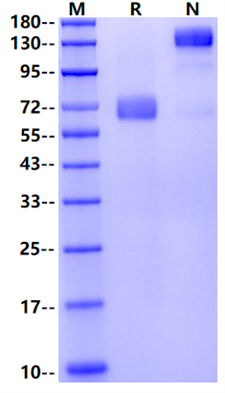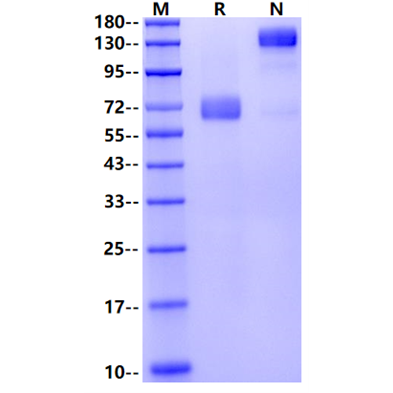1μg (R: reducing condition, N: non-reducing condition).
Product Details
Product Details
Product Specification
| Species | Mouse |
| Antigen | EPCR/PROCR |
| Synonyms | Endothelial cell protein C receptor,Activated protein C receptor, APC receptor, EPCR, PROCR, CD201 |
| Accession | Q64695 |
| Amino Acid Sequence | Leu18-Ser214, with C-terminal Human IgG Fc LCNSDGSQSLHMLQISYFQDNHHVRHQGNASLGKLLTHTLEGPSQNVTILQLQPWQDPESWERTESGLQIYLTQFESLVKLVYRERKENVFFPLTVSCSLGCELPEEEEEGSEPHVFFDVAVNGSAFVSFRPKTAVWVSGSQEPSKAANFTLKQLNAYNRTRYELQEFLQDTCVEFLENHITTQNMKGSQTGRSYTSIEGRMDPKSSDKTHTCPPCPAPELLGGPSVFLFPPKPKDTLMISRTPEVTCVVVDVSHEDPEVKFNWYVDGVEVHNAKTKPREEQYNSTYRVVSVLTVLHQDWLNGKEYKCKVSNKALPAPIEKTISKAKGQPREPQVYTLPPSRDELTKNQVSLTCLVKGFYPSDIAVEWESNGQPENNYKTTPPVLDSDGSFFLYSKLTVDKSRWQQGNVFSCSVMHEALHNHYTQKSLSLSPGK |
| Expression System | HEK293 |
| Molecular Weight | 65-75kDa |
| Purity | >95% by SDS-PAGE |
| Endotoxin | <0.1EU/μg |
| Conjugation | Unconjugated |
| Tag | Human Fc |
| Physical Appearance | Lyophilized Powder |
| Storage Buffer | PBS, pH7.4 |
| Reconstitution | Reconstitute at 0.1-1 mg/ml according to the size in ultrapure water after rapid centrifugation. |
| Stability & Storage | · 12 months from date of receipt, lyophilized powder stored at -20 to -80℃. · 3 months, -20 to -80℃ under sterile conditions after reconstitution. · 1 week, 2 to 8℃ under sterile conditions after reconstitution. · Please avoid repeated freeze-thaw cycles. |
| Reference | 1. Montes, R. et al. (2012) Thromb. Haemost. 107:815. 2. Bae, J.-S. et al. (2007) Blood 110:3909. 3. Fink, K. et al. (2013) PLoS One 8:e53103. 4. Willcox, C.R. et al. (2012) Nat. Immunol. 13:872. 5. Turner, L. et al. (2013) Nature 498:502. |
Background
The endothelial protein C receptor (EPCR), also known as CD201, is an approximately 50 kDa transmembrane glycoprotein expressed on vascular endothelial cells and functions as a negative regulator of thrombosis. EPCR inhibits thrombosis through its interactions with Protein C, activated Protein C (APC), and Coagulation Factors VII, and VIIa. It enhances the activation of Protein C in response to complexes of Thrombin-Thrombomodulin. In humans, a soluble form of EPCR can be produced by alternative splicing or ADAM17/TACE mediated shedding, and this protein inhibits the anti-coagulant activity of APC. EPCR can be degraded on the surface of endothelial cells by Neutrophil Elastase. Activation of EPCR also protects vascular endothelial cells from Thrombin-induced apoptosis.EPCR binds to CD11b/CD18 (Mac-1) on monocytes and mediates monocyte adhesion to the vascular endothelium. In addition, EPCR binds to the antigen receptor on gamma δ T cells, promotes hematopoietic stem cell retention in the bone marrow, and binds to surface proteins of some species of Plasmodium, contributing to pathogenicity in severe malaria.
Picture
Picture
SDS-PAGE



